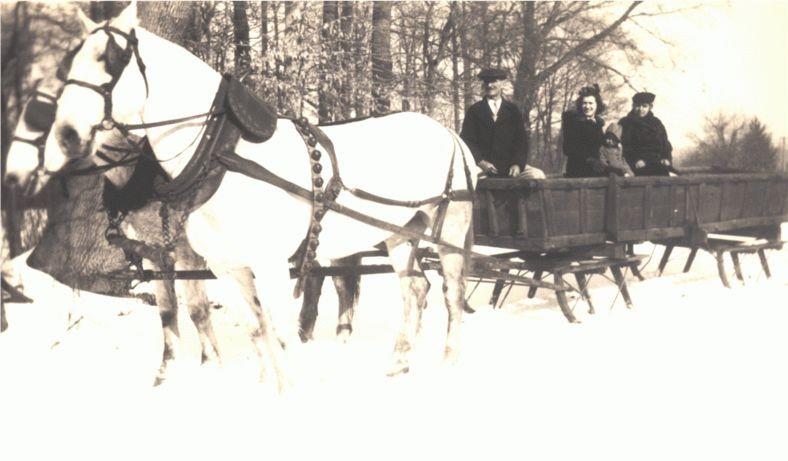By Robin Mayes, Farm Educator

“Over the river and through the woods to Grandmother’s house we go” … almost anyone can remember the words of this quaint song. It conjures up images of a gentle snow falling. Small rolling hills covered with white fluff and the family tucked in under a warm blanket or cow hide in a small sleigh pulled by a sleek horse. This was a sleigh ride under ideal conditions!
Known today as “Jingle Bells,” this well-loved tune was originally published in 1857 as “One Horse Open Sleigh.” Written by James Pierpont, it is now considered a holiday song, but is thought to have been originally written as a celebration of the winter season and the popular past time of sleigh racing.
The lyrics capture a bygone America in which horses served a central role in everyday life. The song evokes in our imaginations what was once a common sight when snow turned the countryside white. Wheels were removed from wagons to be replaced with runners or skids called “bobs” were strapped onto the wheels. Sulkies were swapped out for sleds. And horse-drawn sleighs ruled the roads.
Sledding, skating and sleighrides were all eagerly anticipated social events as winter approached in those days. Sleighing parties were organized and young men took special pride in their small, fast cutters- two-seater sleighs designed to be pulled by a single horse.

In the 19th century, harness racing was extremely popular. During the winter months in northern areas, sled racing took hold as a favorite recreational pursuit. Straight roads covered in packed snow made for excellent racing lanes, and horsemen hitched their finest trotters for organized and spontaneous races, much to the excitement of onlookers. Local newspapers from the 1800s and early 1900s included the latest sleigh racing reports, dutifully describing the race conditions, cataloguing the winners, and analyzing the breed of the best horses. Though virtually any horse or pony could be called upon to pull a sled, the best, lean horses were called upon for sleigh races. A horse that could trot “two forty” like the bobtailed bay referenced in “Jingle Bells” could cover a mile in two minutes and 40 seconds—a speedy trot indeed! As the song alludes, the tails of trotters were often bobbed or docked to keep it from being entangled in the harness.
Not only ideal for racing, a small cutter was the perfect, cozy vehicle for courting. A soapstone foot-warmer could be heated in the stove or fire and placed on the floor of the cutter to keep the occupants’ toes warm for hours. Hot baked potatoes served a dual purpose on a cross-country sleighride. While inside a coat pocket they added warmth but could eventually be eaten, as well. Add a heavy wool or fur lap-robe to cuddle under and you have the makings of a pretty romantic ride!
The bells associated with sleigh rides were not simply for the rhythmic sounds they created as the horse trotted along. The bells were a safety feature. In some areas, the jingling bells that lined leather harnesses or sleigh shafts were required by law as a precautionary measure. Sled runners glided smoothly over the ground and snow muffled the sounds of horses’ hooves, making horse-drawn sleighs a nearly silent form of transportation. As such, clinking bells helped drivers avoid collisions at intersections and alerted passersby to the approach of a sleigh.
Those bells in various sizes served yet another purpose. They could be used as currency with which to pay a Good Samaritan. The brass bells were of some value and were individually attached to the harness straps. Roads and trail conditions were not ideal and mishaps commonly occurred- such as becoming stuck in a large snowdrift. As alluded to in one of the lesser-known verses of “Jingle Bells.”
“A day or two ago
I thought I’d take a ride
And soon, Miss Fanny Bright
Was seated by my side,
The horse was lean and lank
Misfortune seemed his lot
He got into a drifted bank
And then we got upsot!”
One or two bells could be offered as payment to a passerby who gave assistance. Thus, the term “we’ll be there with bells on” was one of optimism. To arrive “with bells on” meant the travelers were anticipating an uneventful (and thus more enjoyable) trip.
Although it took years for “Jingle Bells” to infiltrate mainstream culture, today it is one of the most widely recognized songs in existence. It has been recorded by hundreds of artists over the decades. This tribute to winter was first conceptualized as a Christmas song in the 1940s thanks to Bing Crosby and The Andrews Sisters’ celebrated recording.
As for sleigh racing, it waned in popularity with each passing year after the introduction of the automobile. Yet even today, the delight of riding in a horse-drawn sleigh lifts the spirits of anyone fortunate enough to do so.
Even if you do not get the opportunity to take a sleigh ride, get out and enjoy the brisk, cool air of winter, whether it be by sledding, cross-country-skiing, ice-skating, snowshoeing or simply walking the park trails! And visit Gallant Farm December 10th between 3 p.m. and 8 p.m. and experience a Winter Evening on the Farm.






